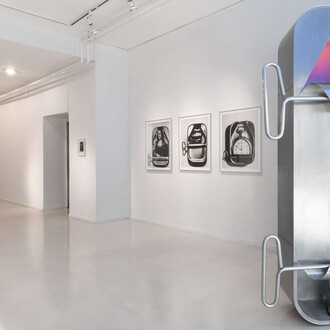A bright past is ahead of us, on view at Škuc Gallery in June and July 2025, explores the concept of generational promises and their impact on contemporary challenges. Curated by Ilija Prokopiev and Marija Hristova, founders of the interdisciplinary curatorial studio PrivatePrint, the exhibition showcases works by five artists: Klelija Živković, Lara Reichmann, Enar de Dios Rodríguez, Gjorgji Despodov and Jaione Cerrato.
These artists’ practices challenge traditional narratives and envision new ways of understanding human and social relations through their diverse practices. They confront issues like environmental crises, economic upheavals and the erasure of marginalised bodies, inviting viewers to question familiar narratives and actively shape a more conscious future. The exhibition explores themes of boundaries, forgotten histories, digital interfaces and the relationship between humans and nature, featuring video installations, mixed media and audiovisual essays.
A bright past is ahead of us explores the unsettling concept of generational promises – ideals and beliefs passed down through lineage that bind us to expectations we may neither trust nor identify with. Using the theory of fairy tale narrative codes as a curatorial pretext, the exhibition features work by five artists, Enar de Dios Rodríguez, Gjorgji Despodov, Jaione Cerrato, Klelija Živković and Lara Reichmann, who envision narratives that challenge our understanding of human and social relations. Set in a semi-darkened space that masks unease, the exhibition contrasts fantastical and poetic elements with stark political, environmental and economic realities. It becomes a site for layered reflection and dialogue, guided by speculative design and documentary methodologies.
Fairy tales articulate the relationship between narrator and audience through shared narrative codes that define the genre. According to Roland Barthes’ structural analysis, mastery over these codes determines the effectiveness of the storyteller. The narrator’s role is not merely to invent stories but to skilfully navigate the established codes in dialogue with the audience. In doing so, fairy tales reflect human psychology and societal values, nurturing identification in people and reinforcing ideals such as the notion of “happily ever after”. Passed down through generations, they preserve shared values and strengthen communal bonds.
Fairy tales offer a safe space contained by the promise that good will triumph over evil as long as the lesson is learned. The narrative arc, framed by “once upon a time” and “happily ever after” provides a reassuring sense of order. Psychologists argue that the darkness inside these endpoints is essential as it provides a symbolic confrontation with fear. Yet, the fairy tale remains a protected space, anchored by faith in a positive outcome. Without that faith, the fairy tale mirrors real-life uncertainty: the hero may falter and the danger may not be overcome. This, in turn, raises a deeper question: what are the contours of uncertainty in a world where “happily ever after” is no longer a sufficient answer?
A bright past is ahead of us confronts the shattered promise of a bright future passed down through generations in the face of contemporary challenges such as human rights violations, wars, environmental crises and economic upheavals. The featured artists, representing diverse backgrounds, guide us through narratives that examine reality through interdisciplinary, research-driven and collaborative practices, framing the present as a space of both anxiety and responsibility and a catalyst for breaking the codes of inert behaviour.
Enar de Dios Rodríguez interrogates the physical and conceptual politics of space, revealing the infrastructures and ideologies that shape our sense of ownership, freedom and belonging. In her video essay Above all, she turns her gaze skyward, challenging the romantic notion of the sky as boundless and untouched. Instead, she exposes it as a contested zone – occupied, surveilled and exploited. Through poetic narration and layered visuals, Rodríguez resists linear storytelling, favouring fragmentation to provoke reflection on access, the commons and systems that shape our environments.
Gjorgji Despodov explores memory, material culture and speculative futures. His practice critiques societal norms and digital overconsumption, questioning what we preserve or discard and the legacy we leave behind. In Where I post from, Despodov reimagines technology as an artefact of the future. Through 3D-printed forms and fictional archives, he examines how data-driven societies construct meaning and heritage, prompting us to reconsider the roles and values passed to future generations.
Jaione Cerrato’s practice critically examines how we frame, aestheticise and distance ourselves from nature. Rooted in ecological thought and speculative futures, her work challenges the anthropocentric gaze that reduces nature to image, symbol or resource. In Framed, Cerrato exposes our paradoxical desire to protect and control the natural world, questioning the aestheticisation embedded in everyday visual culture. Through minimal imagery and poetic text, she invites reflection on our place within a living, interdependent system in transformation.
Klelija Živković’s art practice explores aliveness as a radical form of resistance – an embodied response to systems of oppression, inherited shame and emotional suppression. Her work invites us to see aliveness not as a given but as a skill: something to be learned, nurtured and shared. Through her works, Živković constructs spaces where emotional truths are both confronted and transformed. She offers a language of resilience – one grounded in emotion, collectivity and the quiet power of staying present in a world that often demands disconnection.
Lara Reichmann analyses how marginalised bodies – especially women’s – are transformed within systems of labour, science and technology. Merging historical fact with speculative fiction, she reveals how essential contributions are overlooked or mechanised. In Disposable bodies, she reflects on the Women Astronomical Computers, using metaphor and poetic narrative to question who is remembered and how bodies become disposable in data-centric systems.
The works featured in the exhibition explore questions of the future and inherited promises, each offering a distinct perspective. By embracing uncertainty, the exhibition invites viewers to question familiar narratives, break away from entrenched patterns, and actively shape a more conscious and hopeful future.












